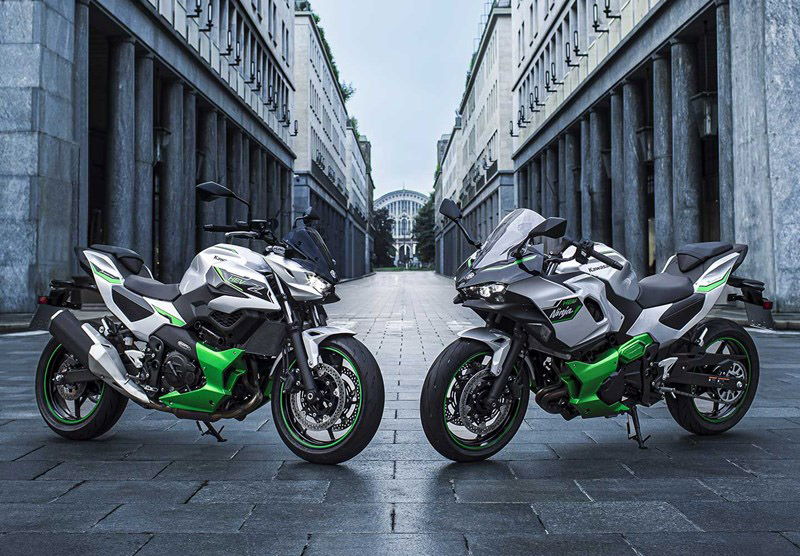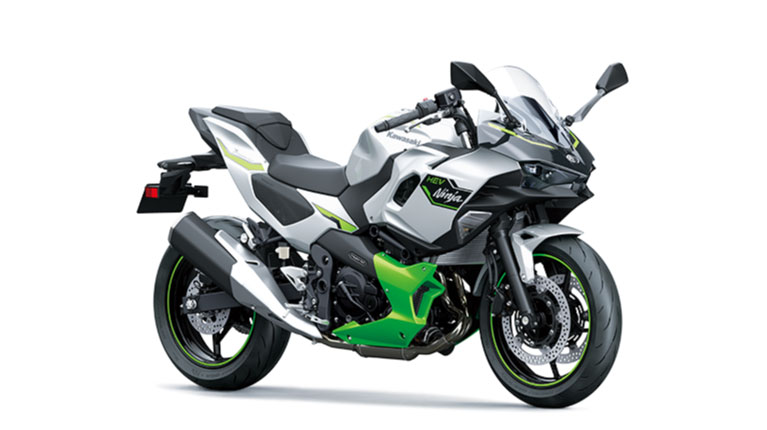Ninja 7 and Z7: Kawasaki’s Hybrid Ideas
Kawasaki ventures boldly into the electric era with a unique solution: the Ninja 7 – a hybrid alternative.
Let’s address the clear facts first. The Ninja 7 and the Z7, like many other Kawasaki models, are built on the same platform but come in slightly varied aesthetic packages – either faired or naked. Contrary to other Kawasaki models, the “7” in the name does not correspond to the engine’s displacement. The engine is the familiar 451cc parallel twin, fine-tuned to power the new Eliminator 500 and several other newly released bikes from Kawasaki.
Interestingly, in this case, the parallel twin engine receives a boost from an electric traction motor, providing an extra push when required. This can be particularly useful in certain urban areas, not yet in Canada but likely in the future, where emission-free vehicles are mandatory. In such zones, the electric motor could be the sole power source, although speed and range would be limited.

The electric motor is part of a “strong hybrid” system working in unison with the internal combustion engine (ICE) to generate additional power through the “eBoost” system. Kawasaki asserts that the Ninja 7 can outpace a ZX10RR from a standstill “initially” and “under certain conditions”, which we presume doesn’t involve the ZX10RR being tied to a pallet of bricks. This claim is plausible, as the electric motor’s torque is instantly available, so “initially” might refer to the first 200 feet.The Ninja 7 and Z7 can operate in three distinct modes: full EV, albeit for a very short range, ECO-Hybrid emphasizing fuel efficiency in urban environments (Kawasaki claims it’s even more fuel-efficient than the Ninja 250), and Sport-Hybrid, where the Ninja 7 offers the riding characteristics of a 650cc bike.The primary performance claims revolve around the eBoost system, which can be engaged for 5-second bursts to allow the electric motor to deliver additional power – akin to a “Punch it, Chewie” approach to speed.Concerning the weight? It’s not too bad, actually. The bike weighs in at 503lbs – heavy, but not unmanageable. The Ninja 7 and Z7 come equipped with a WALK mode for easier maneuvering when pushing is required.The Ninja 7 and the Z7 represent intriguing concepts to adapt to future scenarios where zero-emissions transportation is occasionally mandatory. There are engineering advancements that will benefit other bikes, such as the button-shifting 6-speed transmission. However, this cutting-edge technology and engineering prowess come with a hefty price tag. Both the Ninja 7 and the Z7 will retail at $15,699.
The Ninfa 7 and Z7 can be ridden in three different modes: complete EV although for a very, very short distance, ECO-Hybrid which emphasizes fuel efficiency in urban environs (Kawasaki claims even better fuel economy than theiNinja 250), and finally, Sport-Hybrid where the Ninja 7 is said t0 provide the riding characteristics of a 650cc bike.
The big performance claims are based around the eBoost system that can be applied for 5 second intervals to allow the electric motor to supply extra power. Sort of a “Punch it, Chewie” approach to speed.
What about the weight? Good question. It isn’t actually that bad. The bike comes in a 503lb. Hefty but not unmanageable. The Ninja 7/ Z7 does have WALK mode if you do need to push it around.
The Ninja 7 and the Z7 are absolutely interesting ideas to accommodate a future scenario where zero emissions are required at some times but not at others. There are engineering break throughs that will trickle down to other bikes – including items like the button shifting 6 speed transmission. But all that tech and engineering genius is expensive. The Ninja 7 is going to be $15,699, as will be the Z7.

